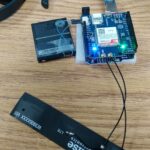I wanted to start playing around with cellular devices and using them with the Arduino. So, I bought a Botletics SIM7000 LTE CAT-M1 NB-IoT Cellular + GPS + Antenna Shield Kit for Arduino (SIM7000A) that works in my locale. There are different modules, SIM7000 A,C,E, etc. that work in different places, so I picked up this one which works with AT&T as well as Verizon LTE bands in my area.
So far, I’m just getting started, and I haven’t done much yet. You can head over to the wiki to see the available open source software and examples are available. I love Open Source Hardware (OSHW)! It is really nice buying a piece of equipment and seeing all of the available diagrams, schematics, software, etc., all laid out for you to use.
In any event, I’m just getting started with this, and so far all I’ve done is register my new Hologram.io sim card, and set it up with an LTE demo sketch. Essentially, the demo sketch allows you to connect over USB with the Arduino serial monitor and use a text based menu interface to play around with the modem, without having to know all of the AT commands.
Here’s a screenshot of my Hologram dashboard:

Of course there is more information on the upper parts of the page, but I felt it was probably wise not to include my IEMI and other information on this shot. The dashboard is really intuitive. As for Hologram.io itself, so far so good. When I signed up they sent me a free card in the mail, as well as gave me 1 MB of free data a month to play with. Sending text messages to the device is free, but sending a text from the device costs 19 cents each. Overall, the monthly charge is $1.50/month to keep the card active. I think it is 40 cents for each additional MB of data I use.
The price seems a bit much for each SMS sent, but it is nice to allow me to play with this without having to get a $30+/month sim card for another carrier. I was going to try some of my other sims in it from my other phones, but you do need a phone sim that specifically does CAT-M1, which supposedly not all do.
One item of note is that the modem will not work without a battery while plugged into the Arduino. It turns out that the Arduino can’t supply enough juice during some operations that cause it to pull a little extra juice. These spikes are sporadic, and while the battery is plugged in, the battery is charged by the board, so my battery level keeps going up while plugged in.
The interesting thing about the battery is that I couldn’t get any place to ship me a battery in the mail to Alaska. Fortunately, I have several dead Android phones laying around and I pulled a 3.7v, 1400mAH battery out of one and was able to solder the wires to the terminals and hook it up that way. Check out the pictures if you want to see my handy work.
I’ll let you know as I try out a few of the features what I can come up with. I’m hoping to build some sort of rudimentary texting/web phone, and grow in some lower level cellular/gps knowledge. As always, you can follow along with my sketches on my GitLab!
Linux – keep it simple.

